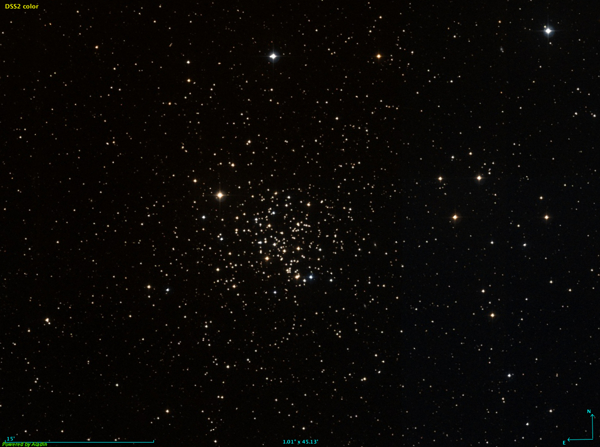Messier 67 in Cancer
February 2023 - Nebula and Cluster of the Month
It has to be admitted that February is a very poor month for nebulae and clusters. The Milky Way has passed its winter zenith, and the faint galaxy fields that precede the richer hunting grounds of Leo dominate the midnight sky in the middle of the month.
Culminating this month is the ancient constellation of Cancer, the Crab. From a naked-eye point of view, it’s a fairly unremarkable area of sky. Dark skies show a wonky ‘K’ shape made of fourth-magnitude stars. A dark sky will also show one of the few deep-sky objects known to the ancients, the open cluster we now call M44.
Charles Messier catalogued another open cluster in this constellation, number 67 in his list of nebulae and star clusters published in the Almanac Connaissance des Temps (‘Knowledge of the Time’), first including M67 in the list of 68 objects published in 1783.

Messier was not the first to see M67, nor the first to publish its presence. That honour goes to Johann Gottfried Koehler (1745-1801), a contemporary of Messier who discovered 20 objects, including M59, M60 and M 67. Although it isn’t clear exactly when he first discovered the object, it must have been between 1772 and 1779. He published his discoveries in the Astronomisches Jahrbuch in 1780. His description reads A fairly discernible nebula of oblong shape near alpha Cancri.
It would seem that Koehler’s telescope wasn’t up to resolving the cluster into stars.
Messier observed the cluster on 6th April 1780, writing A cluster of small stars with nebulosity below the southern claw of the Crab.
Messier’s telescope, then, was slightly (but only slightly) superior to Koehler’s.
William Herschel observed it in 1783. He wrote A very beautiful and pretty much compressed cluster of stars, easily to be seen by any good telescope and in which I have observed above 200 stars at once in the field of view of my great telescope with a power of 157.
Curiously, in a later note, penned in 1809, he wrote A cluster of very small stars. There seems to be a faint milky nebulosity among them.
M67 lies at a distance of about (measurements vary) 800 – 900pc (say 2,700 ly). It is well-populated with stars. Again, estimates vary, but Archinal & Hynes give a very precise 324. It covers a diameter of about 25’ on the sky, though the ‘obvious’ members cover only about 12’. The Trumpler classification is given usually as II2r or II3r (detached from the background, little central condensation, moderate (or wide) range in the brightness of the individual stars, rich). Older catalogues occasionally class its richness as medium, instead of rich. These can be safely ignored. The late Kenneth Glyn Jones (a former president of the Webb Society) in Messier’s Nebulae and Star Clusters (1968) writes M. 67 is known to contain 500 stars between mag. 10 and mag. 16 and a very large number of stars which are fainter still.
M67 lies well above the plane of the galaxy, which has preserved the cluster during a lifetime that would see clusters that live within the disruption of the galactic plane long evaporated. It is not the oldest open cluster known, but it is one of them. It’s the closest old cluster to us and as such has been extensively studied. Many of the stars within it are solar mass stars about the same age as the Sun, making it an ideal laboratory for the study of Sun-like stars. Over 100 stars of this type have been discovered in M67. About 15% of those stars are relatively quiescent, showing far less magnetic activity than our Sun, whilst 30% show activity significantly greater than that of the Sun at maximum.
A survey of 20 solar-like stars within the cluster determined the spin rate of each to be approximately 26 days, very comparable with the Sun’s 25.4 days.
Three exoplanets have been found in M67, around different stars, one of which is of solar type. All these planets are hot Jupiters.
Visually, M67 is a very pleasing object. It is easy to find, being just 1.5° due west of α Cancri. With a total integrated magnitude of 6.9, it stands out well in binoculars. In a small telescope the cluster is compressed and spangly, with many stars of around 10th magnitude. Larger apertures will reveal a wealth of fainter stars, down to around 15th magnitude. The overall shape, I find, is reminiscent of a goblet or a fruit bowl. The main part of the bowl is represented by a reverse ‘C’ shape which opens up to the west and in a small telescope appears almost devoid of stars, with the exception of a delicate little triple star. In larger apertures this shape is rather obscured by a number of fainter stars. Chains and curves of stars abound here, making M67 a very satisfying cluster to observe.
| Object | RA | Dec | Type | Magnitude |
|---|---|---|---|---|
| M 67 | 08h 51’ 19” | +11° 49’ 17” | Open cluster | 6.9 |